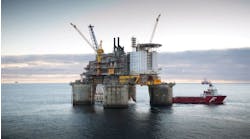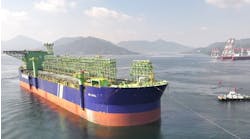Judging magnitude of undiscovered oil and gas
Jean Laherrere
Geologist
- Gulf of Mexico OCS 1995 vs 1996 percentage change versus discovery year (image courtesy of J. Laherrere). [34,354 bytes]
- Parabolic fractal before growth and after growth (image courtesy of J. Laherrere). [28,726 bytes]
- Gulf of Mexico Creaming curve before growth and after growth (image courtesy of J. Laherrere). [30,336 bytes]
- Gulf of Mexico OCS Creaming curve after growth (image courtesy of J. Laherrere). [31,791 bytes]
- Selection of a natural domain, namely the petroleum system or a very large area (continent or the world)
- Use of proved plus probable = P50 reserves which has only a small field growth (if any)
- Field distribution on a size-rank log-log display being close to a parabolic fractal (Laherrere, 1996, 1998)
- Creaming curve - the cumulative number of fields per category versus the cumulative number of new field wildcats modeled with a hyperbola. The interactive combination of the two models, parabolic fractal and creaming curve, gives the ultimate distribution; first, the yet-in-the-ground, and second, after applying constraints, the yet-to-find.
- An oil equivalence of 1 boe = 10 Mcf. In order to be close to the price equivalence, the gas-to-liquid conversion ratio and the volume-in-place (VIP) as gas is recovered, about twice more than oil from the VIP. The natural distribution is the VIP and not the reserves, depending on economic and technical considerations.
Gulf of Mexico system
The US Gulf of Mexico outer continental shelf ( OCS) is only a part of a series of petroleum systems, which extend into shallower water. But, it is a homogeneous database with a large number of fields, making it worthwhile to apply to our modeling. The US Minerals Man agement Service (MMS) uses proved values, leading to field growth (or reserve appreciation).We will consider the method first without field growth (present data), and second, after growth. In this article, only the graphs after growth (AG) are shown, but showing some before growth (BG) data. The MMS uses a calorific equivalence of 1boe = 5.6 Mcf, giving an undue advantage to gas in the assessment of oil plus (+) gas.
Before field growth (BG)From the 920 fields listed in the 1996 MMS report, ranked by decreasing order, the display size-rank on a log-log format was plotted for each decade 1959, 1969, 1979, 1989, and 1996 for oil plus gas; later for oil only; and then for gas only. Each plot is curved. The plot stays about the same for the largest fields.
We extrapolated the ultimate plot as a parabola fitted to the largest fields. As there is a range for drawing the parabola, we need another independent approach for a better fit. We analyzed the cumulative number of fields per category of a certain size versus time, and later the cumulative number of fields per category of a certain size versus the cumulative number of fields (proved plus unproved) reflecting exploratory activity [we lack the cumulative number of new field wildcats (NFW)]. For oil, we used the following catagories: 200 million bbl, 100 million bbl, 50 million bbl, 10 million bbl, 1 million bbl.
This display, called the creaming curve, shows the typical diminishing return, which is usually modeled with a hyperbola as the simplest fit. The asymptote (tangent to a curve at infinity) of the best-fitted hyperbola for a category is compared with the parabola. Interactively, the best fit between the parabolic fractal and the creaming curves has been decided after trial and error.
Oil and gas
The parabolic fractal display shows that the first 15 largest fields were already found by 1969, and in 1989, the rank for over 100 million boe was 119, when for 1996, it is only 120. The number of fields over 100 million boe is best fitted to a hyperbola of an asymptote of 135, and the best parabola gives a number of 135 fields over 100 million boe. The overall best-rounded fit is for the number of fields per category:| Category | 1996 | Parabola | Hyperbola |
| 200 million boe | 44 | 52 | 50 |
| 100 million boe | 120 | 131 | 135 |
| 50 million boe | 202 | 284 | 270 |
The fit parabolic fractal (PF) is used to compute the number for the category (10 and 1 million boe). The difference between the PF and the present data is the yet-in-the-ground reserves. But, it is obvious that there are asymptotic values, needing an infinite amount of exploratory activity and time.
In a mature basin, it is difficult to envisage that the ultimate number of fields (or NFW) will be more than twice the present number (1,000) and we use a maximum of 2,500 fields. We take the yet-in-the-ground number per size and reduce the number, a few for the large fields, and many for the small fields, to obtain a number yet-to-find, which seems reasonable.
The corresponding reserves are 50 billion boe for 10 million boe, and 53 million boe for 1 million boe. The economic threshold could be applied. We assume that it is around 1 million boe, as many fields of this size have been developed. The 53 billion boe is not far from the 51 billion boe from the creaming curve for 2,500 fields, but very far from the 75 billion boe of the ultimate in the ground boe.
The total potential is around 52 billion bbl (average between 51 and 53 billion bbl) and the present total discovered is 39 billion boe. The total undis covered is around 13 billion boe, quite apart from the 25 billion boe of Report 96-47 for the mean undiscovered re coverable resources, and from the "mini-maxi" range of 21-30 billion boe.
Assessing separately, adding
We have assessed oil and gas separately in the same way. For oil, with an ultimate of 17 billion bbl, the total yet-to-find that is 1 million bbl is 4.5 billion bbl, again far from the 8.3 billion bbl of MMS mean estimate of recoverable undiscovered, and far from the mini-maxi range of 6-11 billion bbl.For gas, the yet-in-the-ground that is 5 bcf is 116 tcf, but the yet-to-find is 44 tcf (or 51 = 203-152 for the creaming curve at 2,500 fields). It is far from the MMS mean estimate of 96 tcf and from the mini-maxi range of 82-110 tcf.
The sum of the last two assess ments of oil and gas give a total of yet-in-the-ground and yet-to-find 1 million boe of 31 billion boe and 12 billion boe, compared with 36 billion boe and 13 billion boe for the combined first assessment. It is within 10% difference, which for us is in the same order of magnitude.
After field growth (AG)
From the web, the field values reported for 1995 and for 1996 were compared. Only 859 fields out of the 899 1995 fields are in the 1996 base. Where is the West Cameron 565 1971 discovery with 802 bcf?Out of 859 fields, there are 205 negative revisions (24%) for gas, against 371 positive revisions. With SPE/WPC 1997 definitions, only 86 negative revisions are permitted, which means that proved has a probability of only 75%. For the 616 oilfields, there are 154 negative revisions, against 251 positive ones, again proved with P75.
The overall changes for these 859 fields were 4% for oil and 6% for gas, and 5% for oil plus gas for a one-year growth. It is quite different from the MMS field growth model, which has an annual growth model of 5% per annum, at around 10 years after discovery. But, 50% of the US Gulf of Mexico OCS had already been discovered 30 years ago. For the last 10 years, only 6% of the total discovered was found.
Applying the MMS field cumulative growth model to the 40 billion boe (12.7 billion bbl and 152 tcf) already found, provides, after growth, an increase of 6.5 billion boe (2 billion bbl and 36 tcf) in the next twenty years. This is close to the MMS reserve appreciation of 8 billion boe (2.2 billion bbl and 33 tcf) of Report 96-47. Applying the annual growth model, the increase is less than 1.5% and 5%, much less than this queer increase (4% and 6%) from 1995 to 1996.
The change from 1995 to 1996 seems to be a correction of a first attempt, which was not very good. It explains why 20 fields that were reported in 1995 disappeared in 1996, and also why the change versus discovery year looks erratic and without any substantial increases for the last discoveries. The trendline of the changes is constant from 1947 to 1996 - around 5%.
The use of proved reserves obliges the industry to neglect probable and possible reserves and leads to field growth or reserves appreciation. The use of proved plus (+) probable, as is done in the North Sea (permitted by the UK accounting procedures) leads to a small overall reserve appreciation.
The MMS field growth model is applied to the fields larger than 50 million boe and to the creaming curve for reserves and for the number of fields over 100 million boe. We plotted the parabola with the best fit with the creaming curves and found the number of fields.
The parabolas for oil plus gas, oil and gas AG are slightly different from the parabolas BG. In fact, the distribution for oil AG is more harmonious than BG. The distribution oil plus gas is bumpier than the data for oil and for gas, showing that the oil equivalence ratio is not a good one.
In the drawing of the PF BG, the ultimate distribution is supposed to take care both of the undiscovered and of the future revisions, if the change is not too great as it is when dealing with proved plus probable.
The PF AG, as drawn, includes both the future revised fields and the undiscovered. The difference between the PF AG and the present data is constrained by the activity assumed maximum order to give the yet-to-add, which includes the reserve appreciation.
The undiscovered defined as the yet- to-add outside the reserve appreciation of the discovered is shown in an accompanying graph.
The discrepancy between the separate estimate of oil and gas, compared to the combined estimate of oil plus gas indicates the uncertainty of such an assessment. In fact, the undiscovered AG is less than the undiscovered estimated BG, as in this case. The field growth is included for a large part in the undiscovered and must be excluded.
Conclusions
The present data on the US Gulf of Mexico OCS need to be improved, as the last revision of 1996, versus the first estimate of 1995, shows too much change to be attributed to only pure field growth. Exploratory well data are also needed.An interactive combination of modeling of parabolic fractal and creaming curves allows one to draw the ultimate distribution of the basin and to extract, with the necessary constraints, the recoverable yet to find.
The use of proved reserves is a handicap in the methodology. It is recommended that the proved plus probable (mean) value be used for such assessment. Our assessment of the recoverable ultimate is about 18 billion bbl for oil, 210 tcf for gas, and 56 billion boe for oil plus gas, very different from MMS estimate of 23 billion bbl for oil, 275 Tcf for gas, and 72 billion boe for oil plus gas.
Our estimate is a first look and could be improved with no great problem, if it is felt that the data are unreliable and that there are more plays still to be discovered. Without knowing the reliability of the data and without better knowledge of the geology and the seismic of the US Gulf of Mexico, I feel unable to estimate the range of uncertainty. But I feel that the MMS range is too narrow: 21-26 billion bbl for oil should be 17-26 billion bbl; 262-289 tcf should be 200-290 tcf for gas.
Jean Laherrere can be reached at e-mail:j.h.laherrere@ infonie.fr or website: www.oilcrisis.com/laherrere
Copyright 1999 Oil & Gas Journal. All Rights Reserved.


